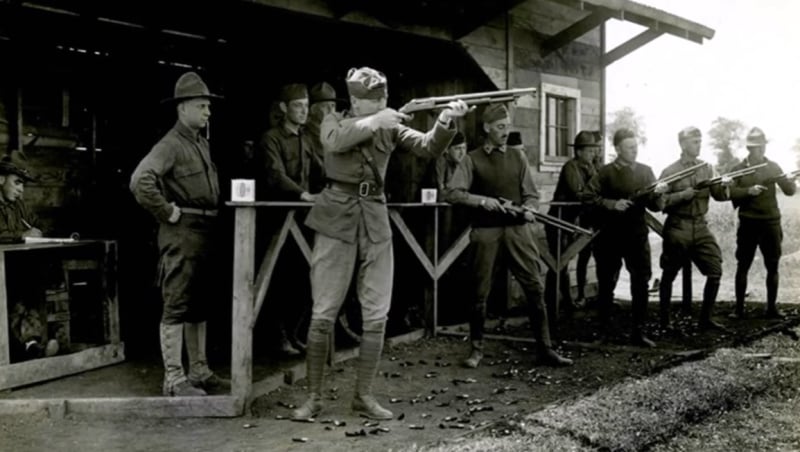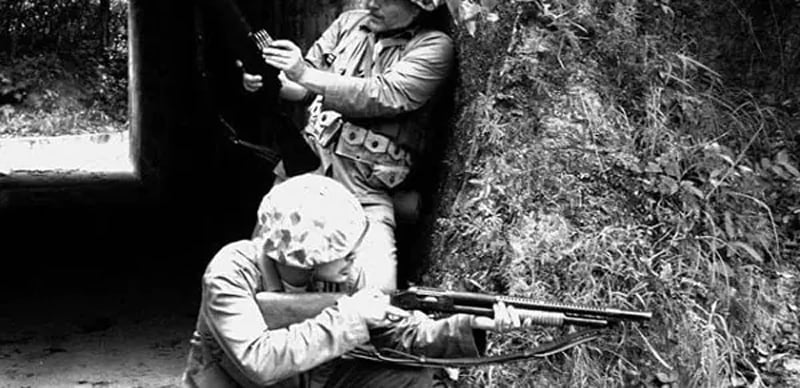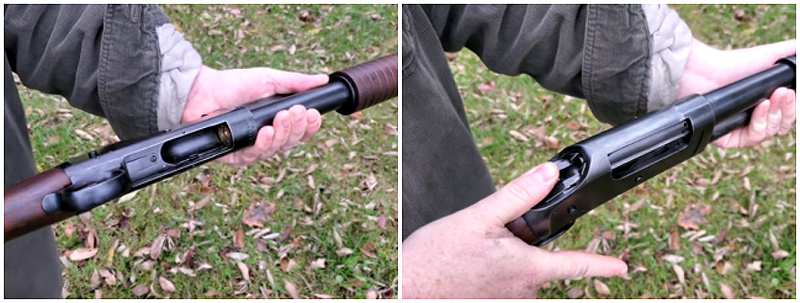The Winchester 1897 Trench Gun is legendary. First deployed with US troops during the Philippine Insurrection of 1899-1902, this beast of a shotgun came into its own during the First World War. By the late fall of 1914, the war in France had devolved into positional warfare fought mainly from vast trench lines that stretched from the English Channel to the Swiss border. I don’t need to rehash the particulars of that, other than to say it was a particularly nasty way to fight.
When soldiers managed to breach their opponent’s line, swinging those long-bayoneted rifles to fight in the confines of a trench was difficult, to say the least. The G98 Mauser, British Enfield, French Lebel, and American Springfield and Enfield were over five feet long with the bayonet attached. Even without the foot and a half of steel blade on the end, the rifles were unwieldy in a tight space.

The British and French had used shotguns in the war, but those were double-barreled guns usually firing birdshot. It’s a European thing. Once the two shells were fired, the
soldier had to break it down and reload from the breech. Probably not any slower than reloading a pump gun, but only having two rounds rendered them less effective than they might have been.
When American troops showed up on the front in 1918, some carrying John Moses Browning’s Winchester trench guns, the game changed. The fast-firing pump action 12 gauges, loaded with double-aught buckshot, wreaked havoc among the Germans unfortunate enough to be in their sights. Even with the 17-inch bayonet attached, the Winchesters were much more effective in a trench than a bolt action rifle or the double-barreled bird guns. Ditto for standing on top of the trench and firing down. On top of that, the Model 1897 does not have a trigger disconnect mechanism, meaning it can be slam fired very quickly. In the hands of a skilled soldier, a slam-fired 12-gauge shotgun would be devastating in that environment, discharging six rounds of double aught buck in about five seconds.

They were so effective, in fact, that the Germans filed an official complaint in Geneva protesting the American use of the shotguns. When US authorities declined to withdraw the guns from service, the Germans announced that they would summarily execute any American soldier caught with a trench shotgun (there were other models too, like the Winchester Model 12 and Remington Model 10, but since this article is about the 1897…). The Americans thought the German complaints were rather rich, coming from an army that deployed mustard and chlorine gas, serrated bayonets, and flamethrowers. The US responded by saying that Germans caught using those weapons would face a similar fate. The Germans let it go.
The Winchester 1897 Trench Gun also saw service in World War II, Korea, and Vietnam and it has become a prime target for military surplus firearms collectors. The Winchesters are so highly sought after that there are more fakes and copies, trying to scam the unwary collector, than there are legit trench guns. There are also real trench guns with incorrect replacement parts, bringing their authenticity into question.

So, YouTube’s Judge Roy Bean, who owns an authentic Great War trench gun, gives us some pointers on how to spot fakes and, if you do find the real thing, how to tell if it’s a WWI or WWII gun.
I also want to point out that there are companies that make reproductions using refurbished and reworked Model 1897 guns. They are up front about the nature of the guns, so I don’t include them with the scammers.

Information Sources
The Judge recommends two books to help you track down and identify a Winchester 1897 Trench Gun, as well as some of the other models. Just as important, they can also help you identify clones, guns with wrong parts, or outright fakes. First is Bruce Canfield’s Complete Guide to United States Military Combat Shotguns. Canfield is well-known for his seemingly encyclopedic firearms knowledge, and he is a trustworthy source. The second is Joe Poyer’s U.S. Winchester Trench and Riot Guns and Other U.S. Combat Shotguns. I’m not familiar with Poyer, but I looked briefly and found that he has published numerous firearms-related books. The excerpts provided in the linked video seem well-informed.

Finally, JRB himself has the first-hand experience of finding and restoring a World War I 1897 Trench Gun, which took over a decade. His diligence in tracking down the correct parts and bringing it back as close as possible to its original condition has surely given him some expertise on the guns themselves.
Features of All Winchester 1897 Trench and Riot Guns
If you’re looking for a trench gun, the first and most obvious thing to do is to check the serial numbers. Once you’ve established that your candidate gun falls within the proper range of numbers, you can start looking at other details. I’m going to lay these out in list form for easier accessibility:
- Serial number range for World War I era trench and riot guns: E613000-E705000
- Serial number range for World War II era trench and riot guns: E921300-E986300
- These serial numbers are rough estimates and authentic trench guns could be outside those ranges by as much as a few hundred either way. Many in that range are trench guns, but some are riot guns purchased by the US government.
- Trench and riot guns had 20-inch barrels. Many fakes have been cut down to that length. The muzzle should be roughly even with the front of the bayonet lug. If not, it’s a fake. If so, that’s good, but you need to look at other things.
- Riot guns had no bayonet adapter. The magazine tube was also connected to the barrel with a barrel band. Trench guns had no barrel band, so look for evidence of one having been removed to spot a fake.
- Trench guns used a plug on the end of the tube that connected directly to the bayonet adapter, so there was no need for a barrel band.
- Authentic trench and riot guns were cylinder bored and marked “CYL” on the left side of the barrel just forward of the receiver. Any other mark, such as “FULL,” means the barrel was cut down from another model.
- Trench guns have the front sight bead on the bayonet adapter. All others, including riot guns, have the bead attached to the barrel near the muzzle. This is not a definite indicator of authenticity. A filled-in hole on the barrel may mean it’s a fake, but some WWII trench guns also had filled in holes where the bead was. Cut down barrels, like the real trench guns, won’t have a bead. You have to use this with other indicators.
- The heat shield/bayonet adapters were easily damaged and may have been replaced with aftermarket parts, even on authentic guns.
- Original trench guns were finished with a rust bluing, but many were Parkerized after the war. Some were partly Parkerized. Some were Parkerized by civilian owners in
later years. - Finally, some of the guns were arsenal refurbished, which is indicated by a stamp on the stock. See the video for more details.

Differentiating Between World War I and World War II 1897 Trench Guns
While the World War I trench guns are more desirable than their World War II counterparts, the later guns are still cool if you can find one. Those are the models that also went
to Korea and Vietnam. I’ll once again do this in list form:

- WWI guns used a solid frame. WWII guns used a takedown style. This is one reason the WWI guns are more sought after. The main reason is the larger, more notorious
role played by the Great War era guns. - WWII guns will likely have a manufacture date stamped on the underside of the barrel near the receiver. The earlier WWI guns will not have that stamp.
- WWI guns will have “Model 1897 Winchester” stamped on the action slide bar. WWII guns do not have that stamp.
- WWI guns have standard Winchester stamps on the left side of the barrel. The right side will be blank. WWII guns have stamps on both sides of the barrel, often including the flaming bomb of the Ordnance Corps on the top.
- WWI heat shields have six staggered rows of 29 holes each. WWII heat shields have four rows of 19 holes.
- Original heat shields on both WWI and WWII guns are riveted to the bayonet lug. Fakes may be soldered or welded. WWI guns had six rivets ground smooth. WWII guns had four rivets, but the finishing wasn’t as nice as their older brothers’.
- Trench gun stocks from both wars should be standard pistol grip walnut with no checkering. WWI guns have a thinner wrist and a higher comb. WWII guns have a thicker, stronger wrist and a lower comb with relief cuts.
- WWII guns are clearly stamped “U.S” with the flaming ordnance bomb on the left side of the receiver. Most WWI guns do not have military markings, though some will have an uneven “U.S.” and flaming ordnance bomb on the right side of the receiver in front of the ejection port.

The Bayonet
The correct bayonet for the Winchester 1897 Trench Gun is the M1917 model, which was also issued with the Enfield M1917 infantry rifle. The M1917 is a 17-inch-long sword bayonet that attaches to the bayonet lug under the muzzle. JRB’s example is an M1917 Type 1. Because of the finishing process, this model bayonet was blued for the first few inches of blade up from the hilt. The rest of the blade was left “in the white.” His bayonet is stamped “1917” with the Winchester logo on one side and “U.S.” with the flaming ordnance bomb on the other.

Operation and Firing
The gun features a five-round tube magazine with the loading gate on the bottom of the receiver. A shell can be loaded directly into the chamber before loading the magazine, giving the gun a capacity of five plus one. As the Judge tells us, the manual of arms is virtually identical to the standard Winchester 1897 Shotgun. The slide must be pressed slightly forward before racking it to the rear. This is a safety feature to allow the gun to naturally unlock under recoil but delay manual operation in case of a hang fire. Be careful of your hand when racking the slide. The bolt comes right out the back of the receiver and will give you a nasty case of slide bite, or bolt bite if you aren’t paying attention.

The only safety is a half-cock mechanism which is set manually. It blocks the trigger and locks the action, but JRB notes that it should not be fully trusted. 1897s are old guns and some may be very worn. Carrying a half-cocked hammer over a live shell may teach you what the phrase “going off half-cocked” really means.


The video ends with the Judge shooting his trench gun for us and even shooting some sporting clays while playing the original recording of Over There. It’s all patriotic and stuff. Plus, he has a sweet, sweet fur hat. I recommend you watch the video, as I simply didn’t have the space to write up all the detail provided therein. It really is very informative and, if you’re looking for a trench gun, may well save you from making an expensive mistake.



